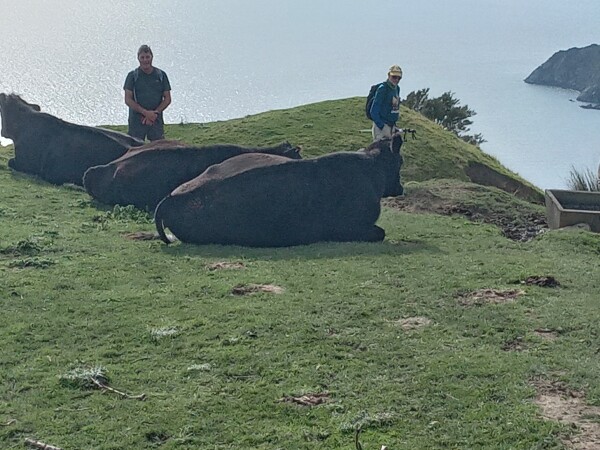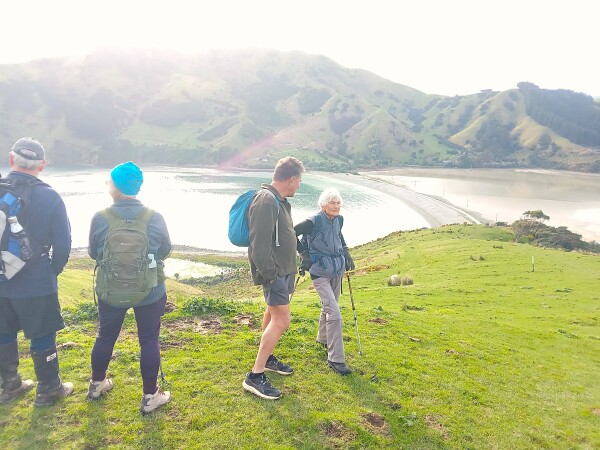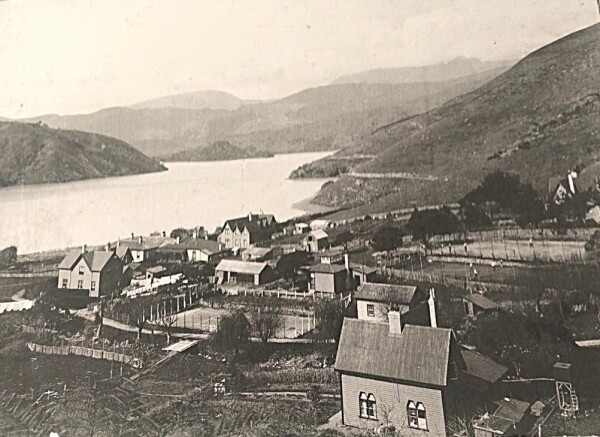Cable Bay Farm marks 150 years of access
Two traditional ways of staying connected—walking access and telegrams—are helping a South Island sheep and beef farm meet modern challenges.
In the early 1980s a public walking track was opened from the settlement of Glenduan, just outside Nelson, through Cable Bay Farm to Cable Bay / Rotokura, where New Zealand’s first telegraph cable came ashore — 150 years ago next February.
Commanding spectacular views over the Horoirangi Marine Reserve and passing through farmland and native bush, the popular two- to three-hour track (one way) has been permanently set aside for public use via a Walkway easement, under the Walking Access Act.

Walkers on the Cable Bay Walkway also get an up-close experience of a working farm. Photo: Marion Gilbertson
Barbara Stuart, whose husband Ian’s family has owned Cable Bay farm since the 1930s, originally made the decision to open the track through their then-1000-hectare coastal hill country farm after an approach from the Lands and Survey department.
The family agreed, in part, because it seemed a good way of dealing with constant requests from people to walk their farm track between Glenduan and Cable Bay.
There were other benefits too, such as Lands and Survey’s part of the deal including support for gorse control.
Another was having access officially controlled according to the family’s needs – such as the annual track closure during lambing season, and the ban on dogs.
Since that time, the family has noticed further advantages of having walkers on their land. One is that their stock is notably quiet and docile.
“People don’t faze them. It can be a selling point.”
Yet another is that walkers occasionally notice something amiss with an animal – perhaps a limp – and let the Stuarts know.
But the family also simply agrees, on principle, with public access, Barbara says.
“Avenues for people to get out into nature, public walkways, are very important for the wellbeing of New Zealanders into the future. You just feel quite proud.”
Barbara said that with farming sometimes being quite isolating, another positive has been meeting people from all over the world.
“Family will come across walkers when they’re on the hill working and have a yarn. Say gidday, where you’re from, how you’re going. It makes their day, in a way – they come home and talk about it. Not every farmer would like that, but these Stuart men like a chat.”

Walkers on the Cable Bay Walkway, overlooking the bay's boulder bank and Pepin Island. Photo: Marion Gilbertson
Economic benefits
Finally, it has made good economic sense too. Barbara says their decision to share the farm with walkers has helped it weather recent headwinds faced by the sheep and beef sector.
“We made the decision to reduce our stock numbers and put in forestry, but that was a long-term solution, and we needed short-term income,” says Barbara, whose son Sam now runs the farm.
The track is now administered by the Department of Conservation, which means no headaches for the Stuarts around track maintenance, management or safety – but also no income, since there’s no entry fee.
But the track’s instant popularity enabled the Stuarts to leverage two businesses off it, opening a campground in 2001, followed by a café.
The bay’s beauty, including a scenic boulder bank linking the shoreline to Pepin Island / Maheipuku, and its rich telegraph history have made it a real destination for walkers, Barbara says.
Next February, Cable Bay Farm will celebrate 150 years since it welcomed the first telegraph cable connecting Aotearoa to the world.
In 1876, a submarine telegraph cable was laid between Sydney and Cable Bay over just 11 days—connecting New Zealand to Australia, the Middle East, and England, and making instant global communication possible for the first time.
“This bay was the centre of communications for New Zealand. You think of the benefits for the generations since then, from that communication with the outside world, and it all started right here.”
Historic photos show how a whole community developed around the Cable Station, Barbara says. As well as telegraph room where Morse code messages were received, there were two tennis courts, a billiard room, a boarding house for telegraph cadets, a blacksmith and a resident reporter.
“It wasn’t just a cable.”
Although a fire destroyed the station in 1914, and the cable operation shifted to Titahi Bay near Wellington in 1917, Cable Bay’s legacy as a place of connection endures.

Cable Bay in the late nineteenth century was a thriving community. Photo: supplied by Barbara Stuart
Staying connected
As well as around 1000 Romney sheep and some Angus beef cattle, Sam Stuart now produces honey on the farm.
The Stuarts harvested their forestry block in 2022 and replanted, now having around 117 hectares in young trees.
Luckily, the roots of the harvested trees were still intact in the ground when the massive 2022 floods hit.
A slip took out the farm’s cattle yards, but Barbara said they got off lightly compared to many in the region.
The same went for the winter 2025 floods, but the ever-more-frequent severe weather certainly isn’t helping, she said.
Meeting that challenge requires adaptability. Recently the family sold 331 ha of their land to another farmer, including 84 ha of forestry.
On a separate title, the sold block includes about half the Walkway, on the Nelson side.
The public’s right to use the Walkway is unchanged, which Barbara said showed the value of establishing public access in perpetuity through the legal instrument of a Walkway.
The new owner has even improved the Walkway gradient on his side, she said.
Much of the walk is over open farmland, affording those amazing coastal views, but there’s also about 1.5km through mature native bush on the part that still belongs to the Stuarts, protected under a QEII National Trust covenant.
Apart from their enduring contributions to conservation and public access, the Stuarts’ positive impact in the region looks set to continue.
Other activities and businesses have leveraged off the Walkway, including an Adventure Park, a sea-kayaking business, an enduro race and professional training for the Coast-to-Coast race.
Barbara’s advice for other landowners considering public access is that it could be very beneficial, but not to expect instant results.
“People know their own land best and what’s likely to work. Our Walkway was well-known to locals, but it took time to get known nationally and internationally.”
The availability of water was also an important consideration, she said.
Looking to the future, she felt Cable Bay could become as popular a tourist destination as nearby Kaiteriteri.
With two granddaughters and a grandson, Barbara hopes the family stays connected to Cable Bay.
“In today’s fast modern world, people need to get into nature, find those special corners and connect. And we realise how important that is.”
Interested in having public access through your land?
More information: Benefits of creating legal access on your land
This article was written as part of a joint project with Beef + Lamb New Zealand, to highlight the ways sheep and beef farmers around the country are supporting public access to the outdoors.
Read more: Tararua farmers open paradise to public
Would you or someone you know like to share a story like this? Get in touch:
media@herengaanuku.govt.nz

